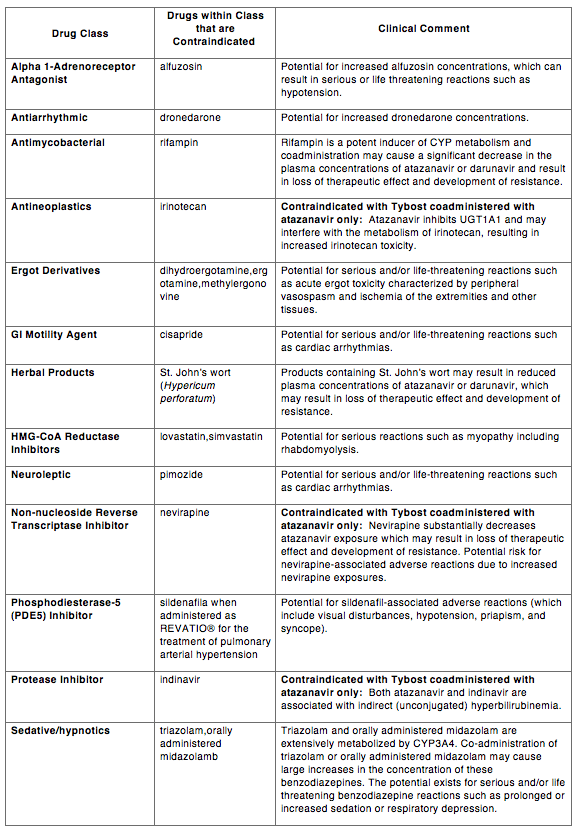| |
Cobicistat/Tybost FDA Approves
|
| |
| |
On September 24, 2014, FDA approved Tybost (cobicistat) 150 mg tablets. Tybost is a CYP3A inhibitor indicated to increase systemic exposure of atazanavir or darunavir (once daily dosing regimen) in combination with other antiretroviral agents in the treatment of HIV-1 infection. The recommended dosages of Tybost and atazanavir or darunavir given with food are presented below.
Recommended Dosing Regimens

The data to support the use of atazanavir and Tybost were from a phase 2 and 3 trial in treatment-naïve adults comparing atazanavir/cobicistat 300/150 mg and atazanavir/ritonavir 300/100 mg once daily each in combination with Truvada. The atazanavir/cobicistat based regimen was non-inferior to the atazanavir/ritonavir based regimen. The data to support the use of cobicistat with darunavir is from a multiple dose trial in healthy subjects comparing the relative bioavailability of darunavir/cobicistat 800/150 mg to darunavir/ritonavir 800/100 mg.
The most common adverse drug reactions observed with Tybost in combination with atazanavir (incidence greater than 10%, all Grades) are jaundice, ocular icterus, and nausea.
The following limitations of use were included section
1 Indications and Usage:
· Tybost is not interchangeable with ritonavir to increase systemic exposure of darunavir 600 mg twice daily, fosamprenavir, saquinavir, or tipranavir due to lack of exposure data. The use of Tybost is not recommended with darunavir 600 mg twice daily, fosamprenavir, saquinavir or tipranavir.
· Complex or unknown mechanisms of drug interactions preclude extrapolation of ritonavir drug interactions to certain Tybost interactions. Tybost and ritonavir when administered with either atazanavir or darunavir may result in different drug interactions when used with concomitant medications.
Prior to starting Tybost, assess estimated creatinine clearance because Tybost decreases estimated creatinine clearance due to inhibition of tubular secretion of creatinine without affecting actual renal glomerular function. When coadministering Tybost with tenofovir disoproxil fumarate (tenofovir DF) assess estimated creatinine clearance, urine glucose, and urine protein at baseline.
Tybost coadministered with tenofovir DF is not recommended in patients who have an estimated creatinine clearance below 70 mL/min because dose adjustment of tenofovir DF is required below 50 mL/min and such dose adjustments have not been established for coadministration with Tybost.
Drugs that are Contraindicated with Concomitant use with Tybost and Atazanavir or Darunavir

A summary of the Warnings and Precautions follows.
· Effects on Serum Creatinine: Assess creatinine clearance (CLcr) before initiating treatment.
· New onset or worsening renal impairment when used with tenofovir disoproxil fumarate: When Tybost is used in combination with a tenofovir disoproxil fumarate (tenofovir DF) containing regimen, cases of acute renal failure and Fanconi syndrome have been reported. (5.2)
· Use with tenofovir DF: Assess urine glucose and urine protein at baseline and monitor CLcr, urine glucose, and urine protein. Monitor serum phosphorus in patients with or at risk for renal impairment. (5.2)
Risk of Serious Adverse Reactions or Loss of Virologic Response Due to Drug Interactions:
· Initiation of Tybost, a CYP3A inhibitor, in patients receiving medications metabolized by CYP3A, or initiation of medications metabolized by CYP3A in patients already receiving Tybost may increase plasma concentration of these medications which may increase the risk of clinically significant adverse reactions (including life-threatening or fatal reactions) associated with the concomitant medications. Coadministration of Tybost with atazanavir or darunavir in combination with CYP3A inducers may lead to lower exposure of cobicistat and atazanavir or darunavir and loss of efficacy of atazanavir or darunavir and possible resistance. Therefore, consider the potential for drug interactions prior to and during Tybost therapy; review concomitant medications during Tybost therapy; and monitor for the adverse reactions associated with the concomitant drugs
· Tybost or ritonavir when administered with either atazanavir or darunavir may result in different drug interactions when used with concomitant medications. Complex or unknown mechanisms of drug interactions preclude extrapolation of ritonavir drug interactions to certain Tybost interactions
· Antiretrovirals that are not recommended: Tybost in combination with more than one antiretroviral that requires pharmacokinetic enhancement (i.e., two protease inhibitors or elvitegravir in combination with a protease inhibitor) is not recommended. Additionally, darunavir in combination with efavirenz, nevirapine or etravirine. Atazanavir in combination with etravirine or in combination with efavirenz in treatment-experienced patients.
· Use with HIV-1 protease inhibitors other than atazanavir or darunavir administered once daily are not recommended.
· Coadministration with cobicistat-containing drugs, including STRIBILD¨, is not recommended.
· Coadministration with drugs or regimens containing ritonavir is not recommended.
Use of Tybost with concomitant medications
The potential for drug interactions must be considered by healthcare providers prior to and during therapy with Tybost coadministered with atazanavir or darunavir.
Healthcare providers should carefully evaluate whether dosage adjustments of concomitant medications or antiretroviral drugs are necessary in:
· Patients on a stable concomitant medication who initiate or switch to a Tybost-containing regimen
· Patients on a Tybost-containing regimen who initiate a new concomitant medication
· Patients initiating a Tybost-containing regimen and a new concomitant medication simultaneously
Under these circumstances, healthcare providers should also monitor for adverse events and/or monitor concentrations of concomitant medications if appropriate.
Tybost increases the systemic exposure of CYP3A substrates, including atazanavir and darunavir, by inhibiting CYP3A. Concomitant use of Tybost with atazanavir or darunavir and other medications metabolized by CYP3A may result in increased plasma concentrations of these medications, which may result in increased adverse reactions and severe, life-threatening or fatal reactions.
Cobicistat is metabolized by CYP3A, and to a minor extent, by CYP2D6. Atazanavir and darunavir are also metabolized by CYP3A. Concomitant use of drug products that act as CYP3A inducers may result in decreased plasma concentrations of cobicistat, atazanavir, or darunavir, and to loss of efficacy of atazanavir or darunavir, and possible resistance.
Labeling for Tybost will be posted soon at Drugs@FDA.
Tybost is a product of Gilead Sciences, Foster City, CA.
Richard Klein
Office of Health and Constituent Affairs
Food and Drug Administration
Kimberly Struble
Division of Antiviral Products
Food and Drug Administration
Steve Morin
Office of Health and Constituent Affairs
Food and Drug Administration
|
|
| |
| |
|
|
|